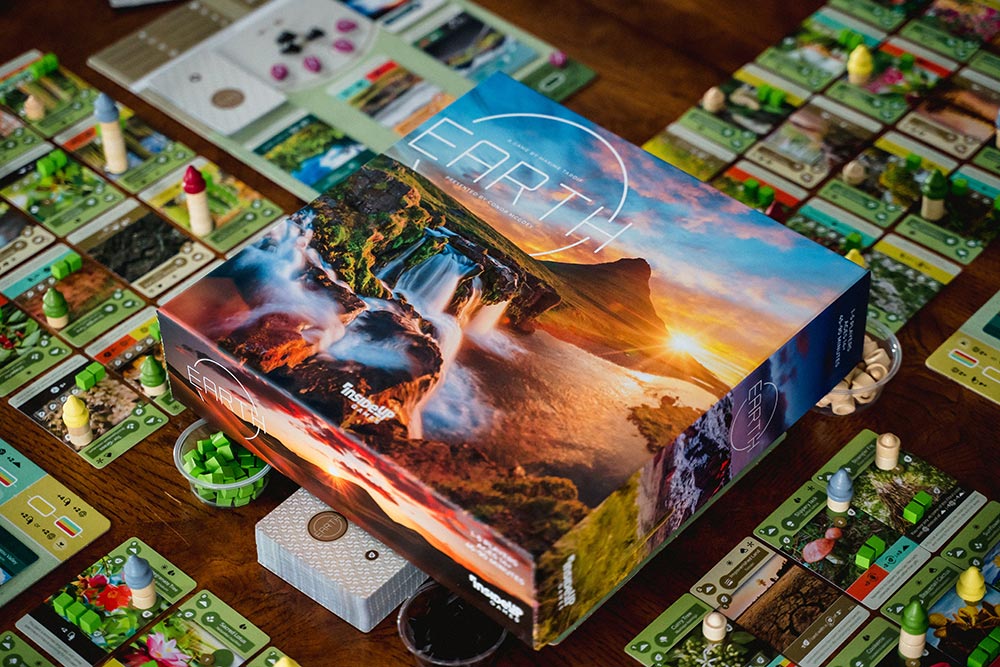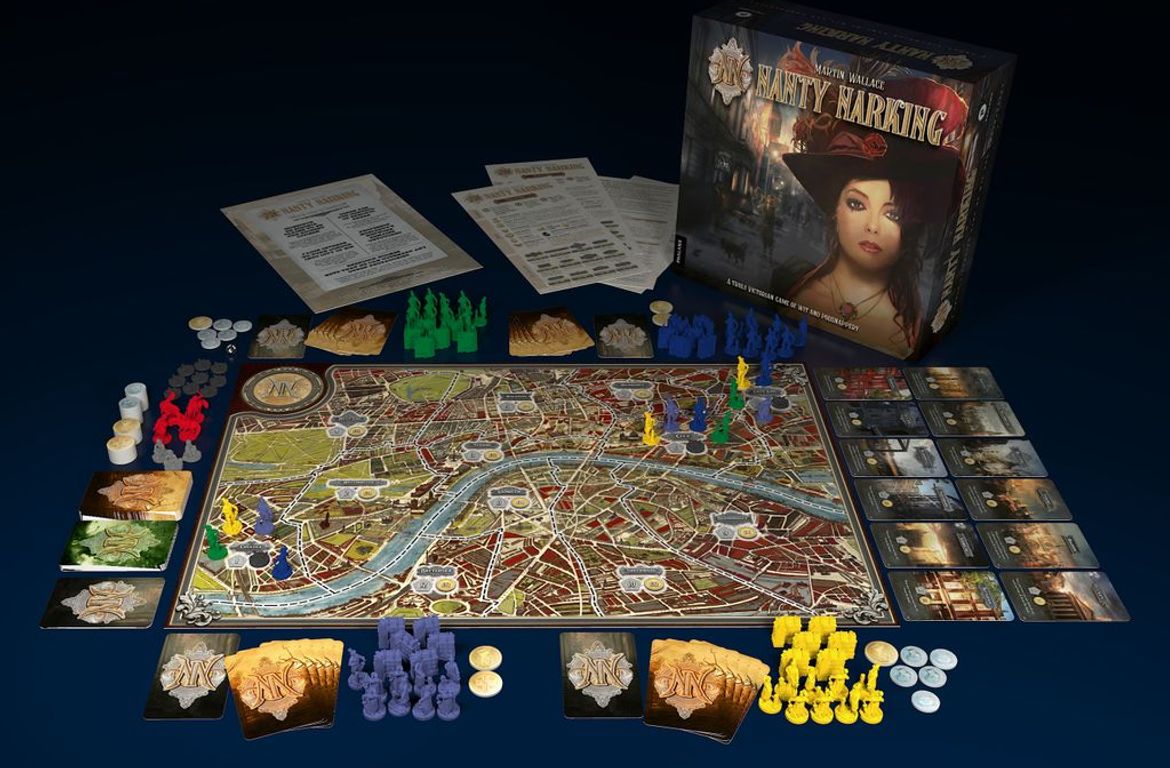
Earth: Istražite Prirodna Čuda planete Zemlje kroz Društvenu Igru
U svijetu društvenih igara, Earth se ističe kao igra koja kombinira ekološku svjesnost, strategiju i prekrasnu umjetnost. Ako ste ljubitelj
As is often the case at SPIEL Essen, the publishers most willing to talk about and show off future releases are French-speaking publishers, whether they’re from Canada, Belgium, or that other place where people speak French.
France’s Blue Orange Games, for example, had a line-up of 2024 releases in its business center, and BOG press officer Cyrielle Mathieu said that everything on display was cleared for coverage. More titles will likely be added in the coming months. At this time, it’s unknown which of these titles, if any, will also be released by the U.S.-based Blue Orange Games as their catalogs don’t always overlap.
• Let’s start with Puerto Banana, a 2-6 player auction party game from Mads Emil Christensen, who debuted with the 2023 title Hard to Get. Puerto Banana is a sealed bid auction game in the spirit of QE:
Your goal in Puerto Banana is to be the first player to collect 500 bananas. Each player starts with 10 bananas, and the first lot up for bid is 10 bananas. You can secretly bid any amount for this lot — even far above 10 bananas!
Mock-up components at SPIEL Essen 23
Players then reveal their bids, and if the player who bid the most can pay the difference between their bid and the next lowest bid, they pay this difference to whoever made that bid, then they win the current lot, adding it to their banana stash; if they can’t, they lose bananas equal to their bid! (A player will always have a minimum of 10 bananas, though.)
You then compare the player with the second-highest bid and the player with the third-highest bid, etc. Eventually either someone wins and pays their bid, or everyone has been reduced to having 10 bananas. In a tie, players split the banana pot.
The next lot is for an amount of bananas equal to whoever has the most bananas. Continue to auction lots until someone has at least 500 bananas on their cargo ship, thereby winning the game.
• Auctions are also the beating heart of Score 5, a card game from Philip duBarry for 2-5 players:
To start, each player has the same five cards — 5, 10, 15, 20, 25 — in one of the five colors. Each round, reveal one card from the deck; cards come in one of the five colors or gray (a joker that can be any color), as well as a value higher than 25.
Mock-up components at SPIEL Essen 23
Each player chooses one or more cards from hand to bid on this revealed card. Whoever bids the most wins this card and adds it to their hand, and the cards with which they placed the bid are redistributed among the other players, with players choosing one card from this bid to add to their hand in order from second-highest bid to lowest. (Numbers on the initial cards serve as tie-breakers, when needed.)
After a certain number of rounds, players sum the highest card of each color in their hand, and whoever has the highest total wins.
The ending of this description is fudged as I don’t recall what triggers the end of the game. The deck contains 26 auctionable cards, but I can’t imagine you go through them all in a twenty-minute game. In any case, you get the idea of how it works.
• Whoforwat is a co-operative party game from designer/artist Edouard (Edoul) Didelot, who regularly creates dadaistic living beings called “zigotos” and who has now designed a game around them:
At the start of each round in this co-operative game, lay out six zigoto cards. Reveal an illustrated question card, such as “Who loves dogs?”, “Who ran through this wall?”, or “Who would be a good couch?”
Mock-up components at SPIEL Essen 23
Players secretly vote on which zigoto seems like the best who for this what, then they reveal their choices. If no zigoto has received more votes than any other, discard all the zigoto cards and play another round; if a zigoto has received more votes than any other, place it aside for the grande finale, then play another round; and if a zigoto received everyone’s vote, place it aside for the grande finale along with a special “connexion” token, then play another round.
Once you’ve set aside six zigotos, lay out those cards, then play the final round. Reveal a question card, then everyone votes and reveals as normal. If you’ve all voted for the same zigoto, you win! If not, discard a connexion token and vote again on this same question. If you run out of connexion tokens before unanimously choosing a zigoto, you lose.
• Traitor Word is a party game of sorts for 3-6 players from Ségolène and Jean-Paul Monnet in which you try to say all the right things without getting called out for doing so:
Ideally a player can say a word on one of their cards. If they do — and no one has accused them of doing so by their next turn — the player reveals the card showing this word, then scores it for 1 point. If someone correctly accuses a player of saying a word held by that player, then the accuser scores that card as 1 point; if the accusation was wrong, then the accused scores 1 point.
The first player to collect 5 points wins.
• Costu’Monsters is a real-time game from Thomas Favrelière for players aged 5+ in which a card is revealed, then you try to dress your monster in its depicted clothes and accessories more quickly than anyone else can dress their monster.
• Night Knight is a new type of pillow fight for 3-6 players courtesy of designers Uri Streigold, Liat Waks, and Naama Weiss:
— With a red card, you must grab a pillow and throw it at someone with a green card. If no one has a green card, though, don’t touch anything!
— With a green card, use your card as a shield to protect yourself from a thrown pillow — unless no one has a red card in which case you’re forbidden to form a card shield.
— With a pink card, grab one of the pillows and lay your head down on it.
— With a blue card that depicts the pillow king, then no one should do anything!
If you do what you’re supposed to do — or don’t do what you’re not supposed to do — then discard your card. If you make a mistake or take action when the king is present, then place your card on the bottom of your stack.
The first player to play their final card wins.
• The next station in the Next Station game series from Matthew Dunstan will be Next Station: Paris, due out in April/May 2024, a few months ahead of the 2024 Summer Olympics in Paris. What a coincidence!
Blue Orange had nothing to reveal about this title other than (1) its forthcoming existence and (2) its status as the easiest iteration of the Next Station series, which makes sense as I can imagine BOG salespeople standing on street corners hawking copies to tourists as yet another souvenir of their experience: “You’ve ridden the Paris Métro. Now create your own version back at home!”
Possibly not the actual cover of Next Station: Paris
• To wrap, I’ll talk about one of BOG’s SPIEL Essen 23 titles: Doctor Rat, a co-operative game from Johannes Krenner that Mathieu described as a cross between Mysterium and Mastermind.
In this game for 2-7 players, one player is Doctor Rat and needs to help all the other players figure out what they can and can’t eat — e.g., not eating plants, or eating only blue and red items — but the doctor is a rat, so they must speak through actions, not words.
To set up, Doctor Rat draws cards to secretly set up the eating rules that each player must figure out. Then in each turn for eight turns, Doctor Rat draws food cards at random, then chooses enough cards from among those drawn that they can place one food card per player on the table.
Doctor Rat’s POV
The players discuss who should eat what — although you don’t have much to discuss in the first turn — then they each take a card and put it in front of themselves. If a player takes a card that doesn’t match their eating rules, Doctor Rat turns this card face down to show the large X on the back.
If a player gets three Xs, they die, which (as you might suspect) is bad. Thankfully, Doctor Rat has a few tokens in their medical kit that can remove an X or swap cards or otherwise keep the other rats from killing themselves.
The players must survive eight turns, then identify their eating conditions in order to win.

U svijetu društvenih igara, Earth se ističe kao igra koja kombinira ekološku svjesnost, strategiju i prekrasnu umjetnost. Ako ste ljubitelj

U svijetu društvenih igara, rijetko koja igra uspijeva obuhvatiti bogatstvo povijesti, strategije i priče poput Nanty Narkinga. Ova igra, smještena